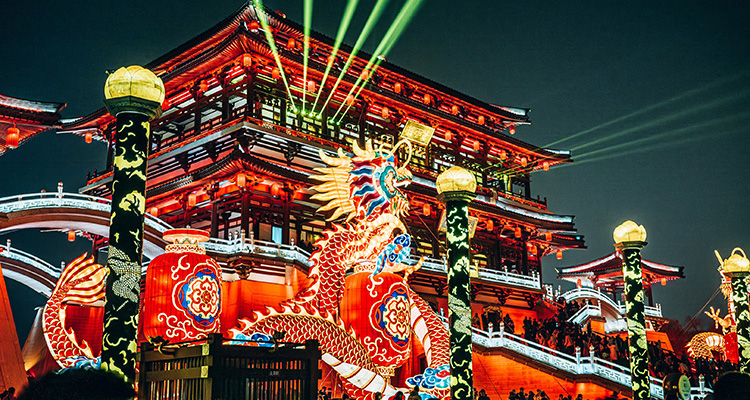Beijing Lantern Festival: Lights, Culture & Fun!
1. A Glimpse of Wonder: Experiencing the Beijing Lantern Festival
Stepping into the Beijing Lantern Festival, you instantly feel the magic of light and culture. “The east wind blows, flowers bloom on a thousand trees; stars fall like rain,” perfectly describes this festival.
Thousands of colorful lanterns illuminate the night, transforming the sky into a vibrant masterpiece. Held at the Beijing Garden Expo Park along the Yongding River, the festival features over 200 lantern displays across nine themed zones. Traditional opera music blends with bright lights, creating a unique atmosphere for visitors.
The highlights include:
- An 18-meter-tall, 22-meter-wide imperial lantern, the largest in Beijing’s history.
- A 10-meter-high “Phoenix” lantern with 40,000 shimmering feathers.
- Two 30-meter-long dragon lanterns soaring majestically.
The festival offers a full sensory experience. From the aroma of street food to the sound of opera and laughter, every sense is engaged. Tasting local snacks like dumplings, roasted meats, and sweet pastries makes the visit even more memorable.

2. A Tradition Steeped in History: The Story Behind the Lantern Festival
The Beijing Lantern Festival has roots in the Han Dynasty. People lit lanterns on the 15th day of the first lunar month to honor Buddha. During the Ming and Qing Dynasties, the festival reached its peak.
In the Qing era, the imperial court celebrated with “Spring Lanterns” inside the palace. Emperor Qianlong would visit the Summer Palace with the Empress Dowager to enjoy lanterns, acrobatics, and fireworks. Lanterns carry cultural meanings: round lanterns symbolize unity, red represents joy, dragon lanterns wish for good weather, and fish lanterns signify abundance.
The lantern festival is not just entertainment; it embodies Chinese cultural heritage. Families gather to enjoy lanterns, creating memories that last generations.

3. Craftsmanship Illuminated: The Art of Lantern Making
Traditional Beijing lanterns showcase expert craftsmanship. Palace lanterns are made with wooden frames and silk, often decorated with embroidery or paper-cut art.
Creating a palace lantern involves multiple skills: drawing, carpentry, painting, and assembly. Artisans carefully design patterns, carve wood, assemble frames, paint, and attach silk with intricate designs. The materials are carefully selected, often using precious wood and high-quality silk, painted with landscapes, flowers, birds, and figures.
Modern lanterns blend tradition with innovation. The “Phoenix Dance in Nine Heavens” lantern uses colored blow-molded paper and transparent acrylic. Standing 10 meters tall with 40,000 feathers, it shows how traditional techniques can merge with contemporary design.
According to art director Yang Yong, “Palace lantern designs borrow from imperial styles, but modern designs allow them to rotate, creating dynamic displays.” This combination of old and new brings lantern art to life.

4. Immersive Experiences: How to Enjoy the Lantern Festival
The best time to visit is half an hour after sunset, when the deep blue sky contrasts with warm lantern lights. The festival is interactive and family-friendly.
At Shijingshan Amusement Park, the “Jingcai Lantern Carnival” lets visitors enjoy rides while viewing lanterns. Evening parades feature giant mech beetle floats at 18:00 and 20:00. At 20:00 and 21:00, the “Iron Flower” performance dazzles spectators as molten iron sparks fly into the night sky.
Lantern riddles, or “Dengmi,” are a traditional interactive activity. Visitors take riddles from lanterns and solve them for fun. Correct answers are celebrated, creating excitement for children and adults alike.
Food is a key part of the festival. At Shijingshan’s “Food & Fun Carnival,” 27 restaurants serve specialties like Quanjude’s duck rolls, Donglaishun’s hot pot, and Liangmahe’s chimney bread. Tasting local delicacies enhances the full festival experience.
5. Planning Your Visit: Where to Experience the Beijing Lantern Festival
Beijing offers festivals throughout the year. Winter’s Lantern Festival around the 15th day of the first lunar month is traditional. Parks like the Temple of Heaven, Summer Palace, and Fragrant Hills host lantern displays.
Summer and autumn festivals are ideal for night visits. Shijingshan Amusement Park’s “Jingcai Lantern Carnival” runs from August 8 to October 31. The park features over 56 large lantern displays and nearly 10,000 lights across seven themed zones.
Notable events include:
- Beijing Garden Expo Park’s “Jingcai Lantern Festival,” one of the largest in history with over 200 lanterns in nine themed areas.
- Shijingshan Amusement Park’s “Jingcai Lantern Carnival,” blending pop culture with traditional lanterns for a youthful audience.
- Wenyu River’s “Wenyu Thousand Lantern Festival,” featuring over a thousand lanterns combining traditional and modern designs.
Workshops by intangible cultural heritage artisans, like Yu Guangliang, offer visitors hands-on experience in making palace lanterns. These classes are held periodically and can be booked online through local cultural committees.

The festival showcases a harmony of history and modern creativity. The roar of mechanical parades, the spectacle of molten iron sparks, and the elegance of traditional palace lanterns combine to create unforgettable memories. Visitors describe the experience as walking through a fairy tale world, filled with vibrant lights and joyous energy.
The Beijing Lantern Festival is a timeless celebration of light, culture, and culinary delights. It awaits your visit, offering a perfect blend of tradition and modernity in China’s ancient capital.


